Attached files
| file | filename |
|---|---|
| 8-K - FORM 8-K - LAW ENFORCEMENT ASSOCIATES CORP | d8k.htm |
Exhibit 99.1
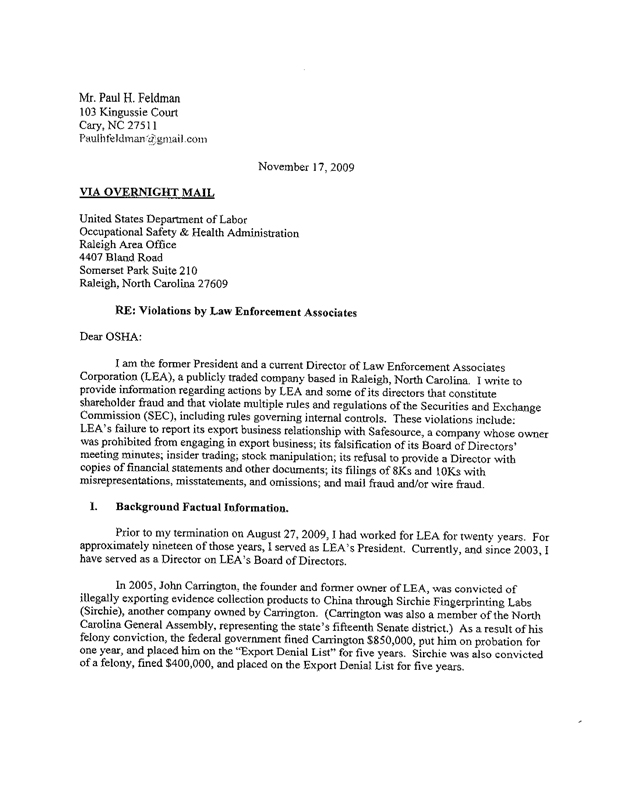
Mr. Paul H. Feldman
103 Kingussie Court
Cary, NC 27511
Paulhfeldman@gmail.com
November 17, 2009
VIA OVERNIGHT MAIL
United States Department of Labor
Occupational Safety & Health Administration
Raleigh Area Office
4407 Bland Road
Somerset Park Suite 210
Raleigh, North Carolina 27609
RE: Violations by Law Enforcement Associates
Dear OSHA:
I am the former President and a current Director of Law Enforcement Associates Corporation (LEA), a publicly traded company based in Raleigh, North Carolina. I write to provide information regarding actions by LEA and some of its directors that constitute shareholder fraud and that violate multiple rules and regulations of the Securities and Exchange Commission (SEC), including rules governing internal controls. These violations include; LEA’s failure to report its export business relationship with Safesource, a: company whose owner was prohibited from engaging in export business; its falsification of its Board of Directors’ meeting minutes; insider trading; stock manipulation; its refusal to provide a Director with copies of financial statements and other documents; its filings of 8Ks and 10Ks with misrepresentations, misstatements, and omissions; and mail fraud and/or wire fraud.
‘. Background Factual Information.
Prior to my termination on August 27, 2009, I had worked for LEA for twenty years. For approximately nineteen of those years, I served as LEA’s President. Currently, and since 2003, I have served as a. Director on LEA’s Board of Directors.
In 2005, John Carrington, the founder and former owner of LEA, was convicted of illegally exporting evidence collection products to China through Sirchie Fingerprinting Labs (Sirchie), another company owned by Carrington. (Carrington was also a member of the North Carolina General Assembly, representing the state’s fifteenth Senate district.) As a result of his felony conviction, the federal government fined Carrington $850,000, put him on probation. for one year, and placed him on the “Export Denial List” for five years. Sirchie was also convicted of a felony, fined $400,000, and placed on the Export Denial List for five years.
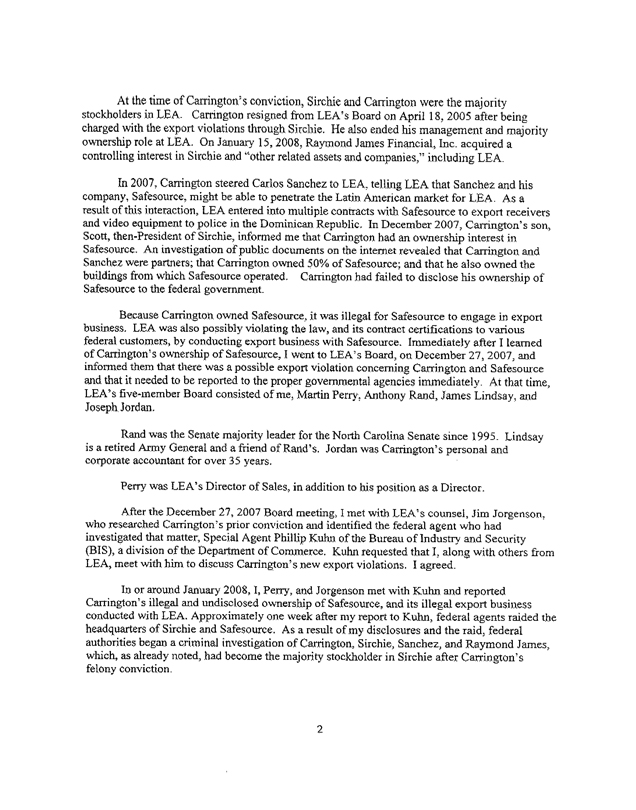
At the time of Carrington’s conviction, Sirchie and Carrington were the majority stockholders in LEA. Carrington resigned from LEA’s Board on April 18, 2005 after being charged with the export violations through Sirchie. He also ended his management and majority ownership role at LEA. On January 15, 2008, Raymond James Financial, Inc. acquired a controlling interest in Sirchie and “other related assets and companies,” including LEA.
In 2007, Carrington steered Carlos Sanchez to LEA, telling LEA that Sanchez and his company, Safesource, might be able to penetrate the Latin American market for LEA. As a result of this interaction, LEA entered into multiple contracts with Safesource to export receivers and video equipment to police in the Dominican Republic. In December 2007, Carrington’s son, Scott, then-President of Sirchie, informed me that Carrington had an ownership interest in Safesource. An investigation of public documents on the internet revealed that Carrington and Sanchez were partners; that Carrington owned 50% of Safesource; and that he also owned the buildings from which Safesource operated. Carrington had failed to disclose his ownership of Safesource to the federal government.
Because Carrington owned Safesource, it was illegal for Safesource to engage in export business. LEA was also possibly violating the law, and its contract certifications to various federal customers, by conducting export business with Safesource. Immediately after I learned of Carrington’s ownership of Safesource, I Went to LEA’s Board, on December 27, 2007, and informed them that there was a possible export violation concerning Carrington and Safesource and, that it needed to be reported to the proper governmental agencies immediately. At that time, LEA’s five-member Board consisted of me, Martin Perry, Anthony Rand, James Lindsay, and Joseph Jordan.
Rand was the Senate majority leader for the North Carolina Senate since 1995. Lindsay is a retired Army General and a friend of Rand’s. Jordan was Carrington’s personal and corporate accountant for over 35 years.
Perry was LEA’s Director of Sales, in addition to his position as a Director.
After the December 27, 2007 Board meeting I met with LEA’s counsel, Jim Jorgenson, who researched Carrington’s prior conviction and identified the federal agent who had investigated that matter, Special Agent Phillip Kuhn of the Bureau of Industry and Security (BIS), a division of the Department of Commerce. Kuhn requested that I, along with others from LEA, meet with him to discuss Carrington’s new export violations. I agreed.
In or around January 2008, I, Perry, and Jorgenson met with Kuhn and reported Carrington’s illegal and undisclosed ownership of Safesource, and its illegal export business conducted with LEA. Approximately one week after my report to Kuhn, federal agents raided the headquarters of Sirchie and Safesource. As a result of my disclosures and the raid, federal authorities began a criminal investigation of Carrington, Sirchie, Sanchez, and Raymond James, which, as already noted, had become the majority stockholder in Sirchie after Carrington’s felony conviction.
3
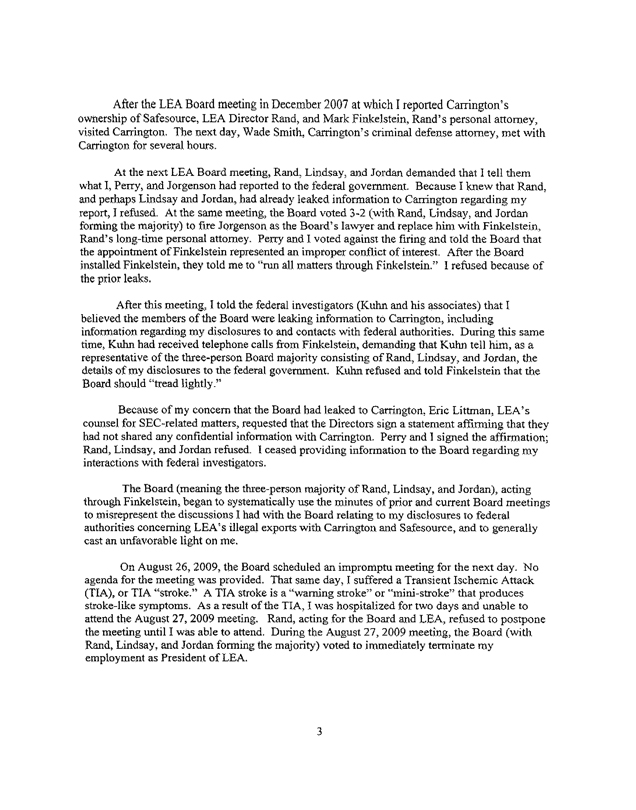
After the LEA Board meeting in December 2007 at which I reported Carrington’s ownership of Safesource, LEA Director Rand, and Mark Finkelstein, Rand’s personal attorney, visited Carrington. The next day, Wade Smith, Carrington’s criminal defense attorney, met with Carrington for several hours.
At the next LEA Board meeting, Rand, Lindsay, and Jordan demanded that I tell them what I, Perry, and Jorgenson had reported to the federal government. Because I knew that Rand and perhaps Lindsay and Jordan, had already leaked information to Carrington regarding my report, I refused. At the same meeting, the Board voted 3-2 (with Rand, Lindsay, and Jordan forming the majority) to fire Jorgenson as the Board’s lawyer and replace him with Finkelstein, Rand’s long-time personal attorney. Perry and I voted against the firing and told the Board that the appointment of Finkelstein represented an improper conflict of interest. After the Board installed Finkelstein, they told me to “run all matters through Finkelstein.” I refused because of the prior leaks.
After this meeting, I told the federal investigators (Kuhn and his associates) that I believed the members of the Board were leaking information to Carrington, including information regarding my disclosures to and contacts with federal authorities. During this same time, Kuhn had received telephone calls from Finkelstein, demanding that Kuhn tell him, as a representative of the three-person Board majority consisting of Rand, Lindsay, and Jordan, the details of my disclosures to the federal government. Kuhn refused and told Finkelstein that the Board should “tread lightly.”
Because of my concern that the Board had leaked to Carrington, Eric Littman, LEA’s counsel for SEC-related matters, requested that the Directors sign a statement affirming that they had not shared any confidential information with Carrington. Perry and I signed the affirmation; Rand, Lindsay, and Jordan refused. I ceased providing information to the Board regarding my interactions with federal investigators.
The Board (meaning the three-person majority of Rand, Lindsay, and Jordan), acting through Finkelstein, began to systematically use the minutes of prior and current Board meetings to misrepresent the discussions I had with the Board relating to my disclosures to federal authorities concerning LEA’s illegal exports with Carrington and Safesource, and to generally cast an unfavorable light on me.
On August 26, 2009, the Board scheduled an impromptu meeting for the next day. No agenda for the meeting was provided. That same day, I suffered a Transient Ischemic Attack (TIA), or TIA “stroke.” A TIA stroke is a “warning stroke” or “mini-stroke” that produces stroke-like symptoms. As a result of the TIA, I was hospitalized for two days and unable to attend the August 27, 2009 meeting. Rand, acting for the Board and LEA, refused to postpone the meeting until I was able to attend. During the August 27, 2009 meeting, the Board (with Rand, Lindsay, and Jordan forming the majority) voted to immediately terminate my employment as President of LEA.
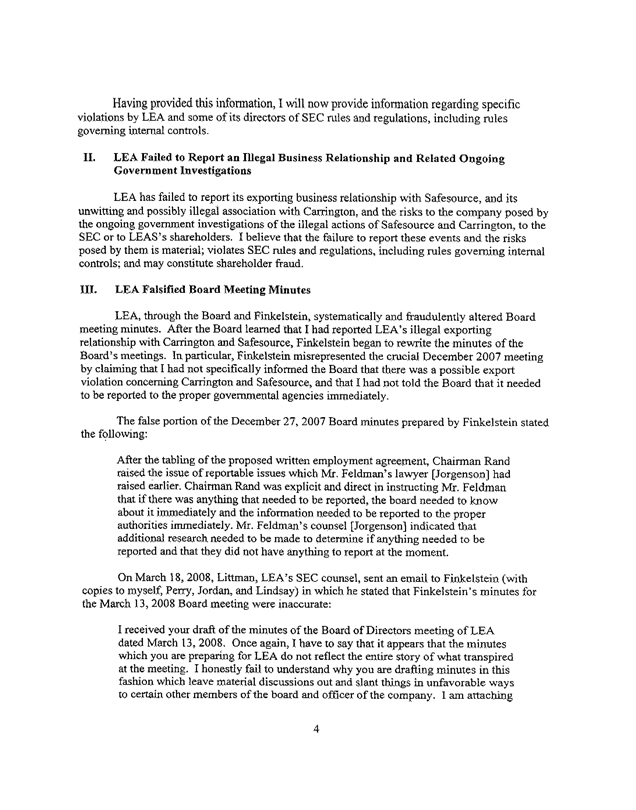
Having provided this information, I will now provide information regarding specific violations by LEA and some of its directors of SEC rules and regulations, including rules governing internal controls.
11. LEA Failed to Report an Illegal Business Relationship and Related Ongoing Government Investigations
LEA has failed to report its exporting business relationship with Safesource, and its unwitting and possibly illegal association with Carrington, and the risks to the company posed by the ongoing government investigations of the illegal actions of Safesource and Carrington, to the SEC or to LEAS’s shareholders. I believe that the failure to report these events and the risks posed by them is material; violates SEC rules and regulations, including rules governing internal controls; and may constitute shareholder fraud.
III. LEA Falsified Board Meeting Minutes
LEA, through the Board and Finkelstein, systematically and fraudulently altered Board meeting minutes. After the Board learned that I had reported LEA’s illegal exporting relationship with Carrington and Safesource, Finkelstein began to rewrite the minutes of the Board’s meetings. In particular, Finkelstein misrepresented the crucial December 2007 meeting by claiming that I had not specifically informed the Board that there was a possible export violation concerning Carrington and Safesource, and that I had not told the Board that it needed to be reported to the proper governmental agencies immediately.
The false portion of the December 27, 2007 Board minutes prepared by Finkelstein stated the following:
After the tabling of the proposed written employment agreement, Chairman Rand raised the issue of reportable issues which Mr. Feldman’s lawyer [Jorgenson] had raised earlier. Chairman Rand was explicit and direct in instructing Mr. Feldman that if there was anything that needed to be reported, the board needed to know about it immediately and the information needed to be reported to the proper authorities immediately. Mr. Feldman’s counsel [Jorgenson] indicated that additional research needed to be made to determine if anything needed to be reported and that they did not have anything to report at the moment.
On March 18, 2008, Littman, LEA’s SEC counsel, sent an email to Finkelstein (with copies to myself, Perry, Jordan, and Lindsay) in which he stated that Finkelstein’s minutes for the March 13, 2008 Board meeting were inaccurate:
I received your draft of the minutes of the Board of Directors meeting of LEA dated March 13, 2008. Once again, I have to say that it appears that the minutes which you are preparing for LEA do not reflect the entire story of what transpired at the meeting. I honestly fail to understand why you are drafting minutes in this fashion which leave material discussions out and slant things in unfavorable ways to certain other members of the board and officer of the company. I am attaching
4
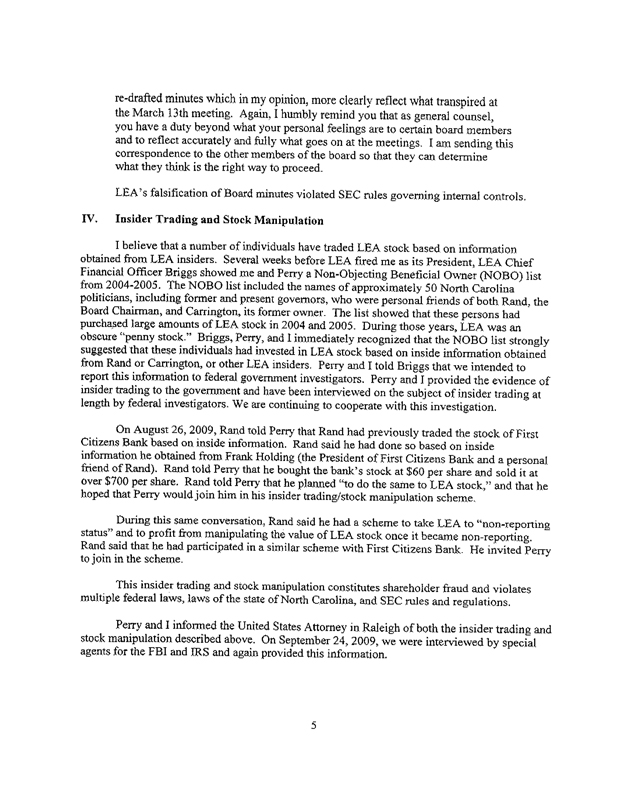
re-drafted minutes which in my opinion, more clearly reflect what transpired at the March 13th meeting. Again, I humbly remind you that as general counsel, you have a duty beyond what your personal feelings are to certain board members and to reflect accurately and fully what goes on at the meetings. I am sending this correspondence to the other members of the board so that they can determine what they think is the right way to proceed.
LEA’s falsification of Board minutes violated SEC rules governing internal controls.
IV. Insider Trading and Stock Manipulation
I believe that a number of individuals have traded LEA stock based, on information obtained from LEA insiders. Several weeks before LEA fired me as its President, LEA Chief Financial Officer Briggs showed me and Perry a Non-Objecting Beneficial Owner (NOBO) list from 2004-2005. The NOBO list included the names of approximately 50 North Carolina politicians, including former and present governors, who were personal friends of both Rand, the Board Chairman, and Carrington, its former owner. The list showed that these persons had purchased large amounts of LEA stock in 2004 and 2005. During those years, LEA was an obscure “penny stock.” Briggs, Perry, and I immediately recognized that the NOBO list strongly suggested that these individuals had invested in LEA stock based on inside information obtained from Rand or Carrington, or other LEA insiders. Perry and I told Briggs that we intended to report this information to federal government investigators. Perry and I provided the evidence of insider trading to the government and have been interviewed on the subject of insider trading at length by federal investigators. We are continuing to cooperate with this investigation.
On August 26, 2009, Rand told Perry that Rand had previously traded the stock of First Citizens Bank based on inside information. Rand said he had done so based on inside information he obtained from Frank Holding (the President of First Citizens Bank and a personal friend of Rand). Rand told Perry that he bought the bank’s stock at $60 per share and sold it at over $700 per share. Rand told Perry that he planned “to do the same to LEA stock,” and that he hoped that Perry would join him in his insider trading/stock manipulation scheme.
During this same conversation, Rand said he had a scheme to take LEA to “non-reporting status” and to profit from manipulating the value of LEA stock once it became non-reporting. Rand said that he had participated in a similar scheme with First Citizens Bank. He invited Perry to join in the scheme.
This insider trading and stock manipulation constitutes shareholder fraud and violates multiple federal laws, laws of the state of North Carolina, and SEC rules and regulations.
Perry and I informed the United States Attorney in Raleigh of both the insider trading and stock manipulation described above. On September 24, 2009, we were interviewed by special agents for the FBI and IRS and again provided this information.
5
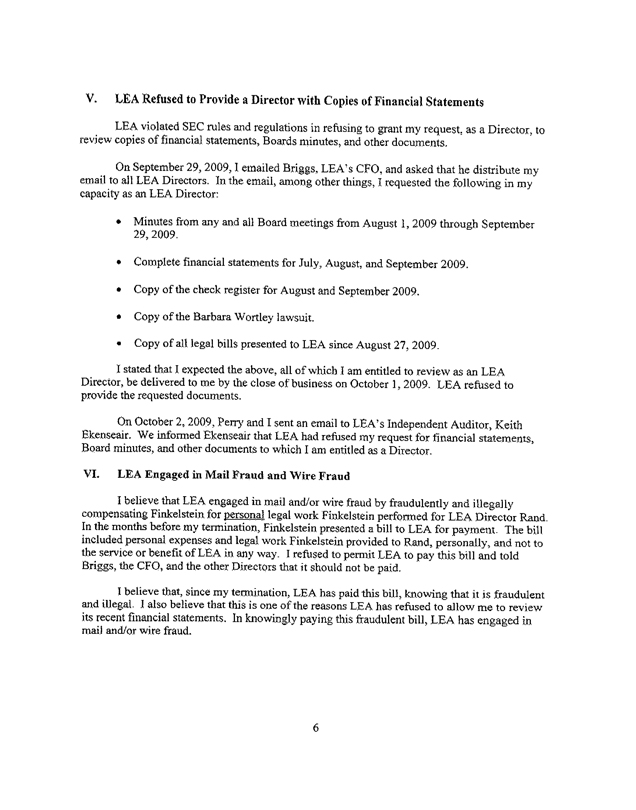
V. LEA Refused to Provide a Director with Copies of Financial Statements
LEA violated SEC rules and regulations in refusing to grant my request, as a Director, to review copies of financial statements, Boards minutes, and other documents.
On September 29, 2009, I emailed Briggs, LEA’S CFO, and asked that he distribute my email to all LEA Directors. In the email, among other things, I requested the following in my capacity as an LEA Director:
• Minutes from any and all Board meetings from August 1, 2009 through September 29, 2009.
• Complete financial statements for July, August, and September 2009.
• Copy of the check register for August and September 2009.
• Copy of the Barbara Wortley lawsuit.
• Copy of all legal bills presented to LEA since August 27, 2009.
I stated that I expected the above, all of which I am entitled to review as an LEA Director, be delivered to me by the close of business on October 1, 2009. LEA refused to provide the requested documents.
On October 2, 2009, Perry and I sent an email to LEA’s Independent Auditor, Keith Ekenseair. We informed Ekenseair that LEA had refused my request for financial statements, Board minutes, and other documents to which I am entitled as a Director.
VI. LEA Engaged in Mail Fraud and Wire Fraud
I believe that LEA engaged in mail and/or wire fraud by fraudulently and illegally compensating Finkelstein for personal legal work Finkelstein performed for LEA Director Rand. In the months before my termination, Finkelstein presented a bill to LEA for payment. The bill included personal expenses and legal work Finkelstein provided to Rand, personally, and not to the service or benefit of LEA in any way. I refused to permit LEA to pay this bill and told Briggs, the CFO, and the other Directors that it should not be paid.
I believe that, since my termination, LEA has paid this bill, knowing that it is fraudulent and illegal. I also believe that this is one of the reasons LEA has refused to allow me to review its recent financial statements. In knowingly paying this fraudulent bill, LEA has engaged in mail and/or wire fraud.6
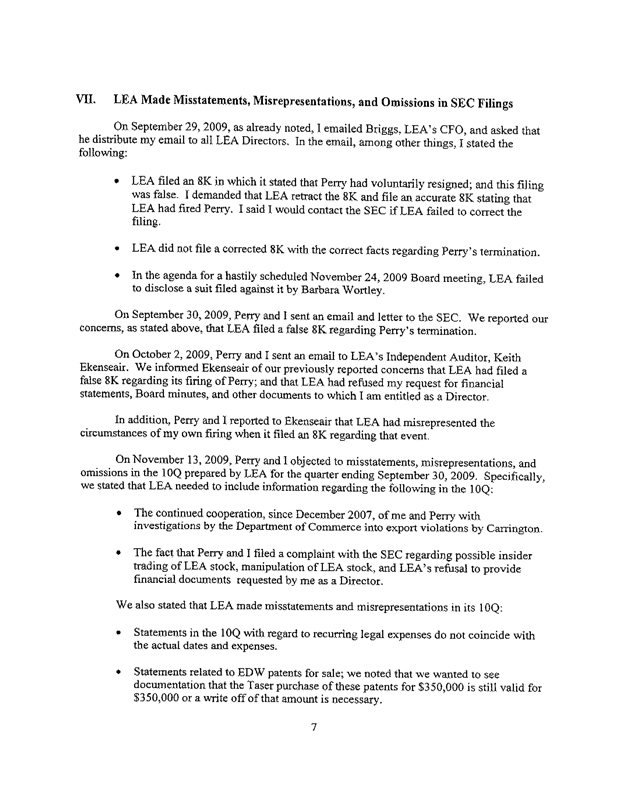
VII. LEA Made Misstatements, Misrepresentations, and Omissions in SEC Filings
On September 29, 2009, as already noted, I emailed Briggs, LEA’s CFO, and asked that he distribute my email to all LEA Directors. In the email, among other things, I stated the following:
LEA filed an 8K in which it stated that Perry had voluntarily resigned; and this filing was false. I demanded that LEA retract the 8K and file an accurate 8K stating that LEA had fired Perry. I said I would contact the SEC if LEA failed to correct the filing.
LEA did not file a corrected 8K with the correct facts regarding Perry’s termination.
In the agenda for a hastily scheduled November 24, 2009 Board meeting, LEA failed to disclose a suit filed against it by Barbara Wortley.
On September 30, 2009, Perry and I sent an email and letter to the SEC. We reported our concerns, as stated above, that LEA filed a false 8K regarding Perry’s termination.
On October 2, 2009, Perry and I sent an email to LEA’s Independent Auditor, Keith Ekenseair. We informed Ekenseair of our previously reported concerns that LEA had filed a false 8K regarding its firing of Perry; and that LEA had refused my request for financial statements, Board minutes, and other documents to which I am entitled as a Director.
In addition, Perry and I reported to Ekenseair that LEA had misrepresented the circumstances of my own firing when it filed an 8K regarding that event.
On November 13, 2009, Perry and I objected to misstatements, misrepresentations, and omissions in the 10Q prepared by LEA for the quarter ending September 30, 2009. Specifically, we stated that LEA needed to include information regarding the following in the 10Q:
The continued cooperation, since December 2007, of me and Perry with investigations by the Department of Commerce into export violations by Carrington.
The fact that Perry and I filed a complaint with the SEC regarding possible insider trading of LEA stock, manipulation of LEA stock, and LEA’s refusal to provide financial documents requested by me as a Director.
We also stated that LEA made misstatements and misrepresentations in its 10Q:
Statements in the 10Q with regard to recurring legal expenses do not coincide with the actual dates and expenses.
Statements related to EDW patents for sale; we noted that we wanted to see documentation that the Taser purchase of these patents for $350,000 is still valid for $350,000 or a write off of that amount is necessary.
7
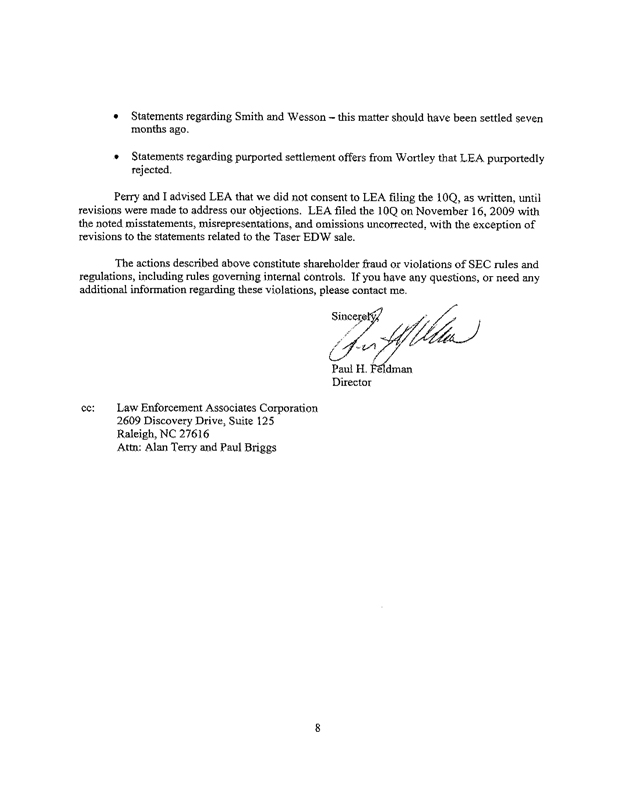
Statements regarding Smith and Wesson – this matter should have been settled seven months ago.
Statements regarding purported settlement offers from Wortley that LEA purportedly rejected.
Perry and I advised LEA that we did not consent to LEA filing the 10Q, as written, until revisions were made to address our objections. LEA filed the 10Q on November 16, 2009 with the noted, misstatements, misrepresentations, and omissions uncorrected, with the exception of revisions to the statements related to the Taser EDW sale.
The actions described above constitute shareholder fraud or violations of SEC rules and regulations, including rules governing internal controls. If you have any questions, or need any additional information regarding these violations, please contact me.
Sincerely,
Paul H.Feldman
Director
cc: Law Enforcement Associates Corporation
2609 Discovery Drive, Suite 125
Raleigh, NC 27616
Attn: Alan Terry and Paul Briggs
8
